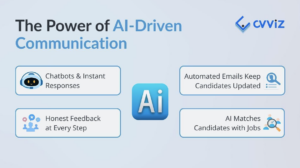The great resignation surprised the world, and employers are scrambling to find talent. For example, in the United Kingdom, organizations struggling to fill talent niches have doubled from 35% in 2019 to 77% in 2021. Currently, 9 million roles stay open in the United States, and it is predicted that there will be 85 million unfilled jobs by 2030.
In the new world of work, people are reassessing their career choices and examining what their employers have to offer. If you are looking to hire the best talent in 2022, you must work on your employer brand to stay competitive in the talent market.
What is Employer Brand
When skilled individuals are out job searching, they look for the best companies hiring in their chosen domain. They are looking for companies with a robust reputation in the talent market and a well-established employer brand.
Recent employer branding statistics reveal that 75% of job seekers look for the employer’s brand before even applying for a role. A good employer brand communicates that the organization is a great place to work. It has a positive culture with a well-established mission, promising growth prospects, attractive perks and benefits, and competitive salaries.
What is Employee Value Proposition (EVP)
EVP (Employee Value Proposition) is a set of benefits that the organization provides its employees. It consists of monetary and non-monetary benefits that incentivize employees to achieve their highest potential at their job.
As an essential factor for building the employer’s brand, EVP is the unique offering you can provide aside from financial compensation. It includes remote working options, flexible working hours, mentorship, career progression, KPI-related bonuses, rewards and recognition, and more.
To sum it up, the EVP is what prospective employees can expect from an organization. With a demanding talent pool that every organization pursues, EVP becomes a key differentiator for employers.
Communicating Your Employer Brand
Whether you have worked on it or not, your employer brand already exists in the form of interactions you have had with your alumni, existing employees, candidates, and potential hires. However, you can also build your brand by actively communicating it. Here are five tips for doing that right:
1. Targeting the right audience
- Communicating your ’employer brand’ is a marketing effort in essence. It would be best to market across different channels, targeting different groups of candidates.
- Create an ideal candidate persona for each category you hire to be as specific as possible and map out the available communication channel for each category.
2. Create compelling content on all channels
- Your employer brand communication is only as good as the content you create around it. In this digital age where people drown in information, your message should be crisp and compelling.
- Short videos and pictures depicting everyday life at your organization are a great place to start on your social media pages. The content posted gives prospective employees a good idea about the company culture, workplace experience, dress code, job openings, titles, and other clues they might be looking for.
- Ensure that your communication channels are optimized for mobile devices as most job-seekers use their phones to search.
3. Make use of storytelling
- Few things promote your brand as effectively as compelling storytelling about your organization and its mission. The key is to tell stories that people can relate to.
- Talk about how your organization has impacted your employees, the community, and the industry.
- Use short movies and blog posts that showcase your efforts to give back to your community and how much your employees are appreciated. Add stories and testimonials from students/graduates in the career pages that readers can empathize with.
4. Become a conversation starter
- Employees these days want to be part of the conversation and have their voices heard instead of being mute spectators. Social media is a powerful tool to start conversations about the well-being of employees.
- Share video content, memes, and blog posts to kickstart conversations about topics relevant to your industry. Establish a dialogue with regular followers and create posts following the organic flow of the conversation.
5. Work on both internal and external branding
- Successful branding always begins from the inside. Organizations need to turn their gaze inwards and involve their employees as part of the narrative.
- What your employees say matters more than your branding efforts ever will. A mismatch between your curated image and the employee story could create distrust among prospective candidates.
- Work on boosting your employee advocacy by creating a positive and transparent work culture that drives engagement.
Communicating Employee Value Proposition
EVP communication should be able to answer why a talented prospect would choose your organization over a competitor. Your messaging should be compelling and delivered across all touchpoints.
Here are four tips for communicating your EVP perfectly:
- Start with your website: Your website is probably the first place prospective employees will look for information about you. Your website career page should show them what it’s like to work in your organization. Testimonials from all employees also weigh in significantly for the EVP.
- Leverage Social Media: Social media is your most effective tool for reaching a wider audience. Creating engaging content on your social media channels demonstrates your commitment to your employees and keeps your social image well-groomed.
- Integrate EVP into Recruitment Events: The impression you leave behind at recruitment events, career fairs, and college recruitment drives cannot be ignored. Communicating your EVP at this stage will pay off in the future in terms of acquiring experienced talent.
- Focus on Candidate Experience: EVP efforts should also encompass potential hires and their experience. A poor recruitment and onboarding experience can make candidates feel alienated. So treat candidates well to cover your EVP efforts at all touchpoints.
Closing Thoughts
The recruitment landscape is more dynamic than ever with candidates looking for more than just a fat paycheck. Employers are implementing competitive strategies to attract and retain top talent as shown by the ever-increasing importance of EVP and employer branding.
What matters the most for today’s workforce is flexibility, benefits, career growth, company culture, workplace experience, rewards & recognition, and competitive compensation. An employer brand and EVP that emphasizes the expectations of prospective candidates is the way forward as the world settles into a new normal of work.



